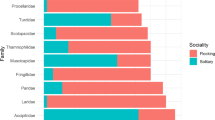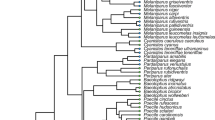Abstract
Adaptive hypotheses for the evolution of group foraging in animals typically invoke enhanced foraging efficiency and reduced predation risk. Net benefits of group foraging in different species should translate into a survival advantage for group members. Despite numerous interspecific studies in birds and mammals, few have documented a survival advantage for group foraging species. Using a large dataset in birds (> 1100 species worldwide), I investigated whether annual adult apparent survival was higher in species that forage in flocks than in solitary species. Using a phylogenetic framework to account for relatedness among species and controlling for known correlates of adult survival in birds such as body size, clutch size, latitude, and diet, I documented a positive effect of flocking on annual adult apparent survival. The increase in survival was less pronounced in occasionally flocking species suggesting that the benefits of group foraging can depend on the frequency of its use. The results highlight how group foraging can increase fitness in animals.



Similar content being viewed by others
Availability of data and material
Dataset is available in Supplementary Information.
Code availability
Not applicable.
References
Batcheller HJ (2017) Interspecific information use by army-ant-following birds. Auk 134:247–255
Baylis SM, de Lisle M, Hauber ME (2014) Inferring maximum lifespan from maximum recorded longevity in the wild carries substantial risk of estimation bias. Ecography 37:770–780
Beauchamp G (2002) Higher-level evolution of intraspecific flock-feeding in birds. Behav Ecol Sociobiol 51:480–487
Beauchamp G (2010) Group-foraging is not associated with longevity in North American birds. Biol Lett 6:42–44
Beauchamp G (2014) Social predation: how group living benefits predators and prey. Academic Press, New York
Beauchamp G (2021) Do avian species survive better on islands? Biol Lett 16:20200643
Bird JP et al (2020) Generation lengths of the world’s birds and their implications for extinction risk. Conserv Biol 34:1252–1261
Blake JG, Loiselle BA (2008) Estimates of apparent survival rates for forest birds in eastern Ecuador. Biotropica 40:485–493
Brawn JD, Karr JR, Nichols JD (1995) Demography of birds in a neotropical forest: effects of allometry, taxonomy, and ecology. Ecology 76:41–51
Bro-Jørgensen J (2012) Longevity in Bovids is promoted by sociality, but reduced by sexual selection. PLoS ONE 7:e45769
Brown CR, Brown MB (2004) Group size and ectoparasitism affect daily survival probability in a colonial bird. Behav Ecol Sociobiol 56:498–511
Brown CR, Covas R, Anderson MD, Brown MB (2003) Multistate estimates of survival and movement in relation to colony size in the sociable weaver. Behav Ecol 14:463–471
Cai YL, Mai CL, Liao WB (2019) Frogs with denser group-spawning mature later and live longer. Sci Rep 9:13776
Cash KJ, McKee MH, Wrona FJ (1993) Short- and long-term consequences of grouping and group foraging in the free-living flatworm Dugesia tigrina. J Anim Ecol 62:529–535
Clark CW, Mangel M (1986) The evolutionary advantages of group foraging. Theor Popul Biol 30:45–75
Clutton-Brock TH et al (1999) Predation, group size and mortality in a cooperative mongoose, Suricata suricatta. J Anim Ecol 68:672–683
Côté IM, Poulin R (1995) Parasitism and group size in social animals: a meta-analysis. Behav Ecol 6:159–165
Crook JH (1964) The evolution of social organisation and visual communication in the weaver birds (Ploceinae). Behav Suppl 10:1–178
Cruz-Angón A, Sillett TS, Greenberg R (2008) An experimental study of habitat selection by birds in a coffee plantation. Ecology 89:921–927
Downing PA, Cornwallis CK, Griffin AS (2015) Sex, long life and the evolutionary transition to cooperative breeding in birds. Proc R Soc Lond B Biol Sci 282:20151663
Dunning JB (2008) CRC handbook of avian body masses, 2nd edn. CRC Press, Boca Raton
Gentry KE et al (2019) Flocking propensity by satellites, but not core members of mixed-species flocks, increases when individuals experience energetic deficits in a poor-quality foraging habitat. PLoS ONE 14:e0209680
Gil MA, Emberts Z, Jones H, St. Mary CM (2017) Social information on fear and food drives animal grouping and fitness. Am Nat 189:227–241
Goodale E, Beauchamp G, Ruxton GD (2017) Mixed–species animal groups: behavior, community ecology and conservation. Academic Press, Oxford
Hackett SJ et al (2008) A phylogenomic study of birds reveals their evolutionary history. Science 320:1763–1768
Ives AR, Dinnage R, Nell LA, Helmus M, Li D (2019) Model based phylogenetic analysis: R package version 1.0.2
Jetz W, Sekercioglu CH, Böhning-Gaese K (2008) The worldwide variation in avian clutch size across species and space. PLoS Biol 6:e303
Jullien M, Clobert J (2000) The survival value of flocking in neotropical birds: reality or fiction? Ecology 81:3416–3430
Jullien M, Thiollay J-M (1998) Multispecies territoriality and dynamic of neotropical forest understorey bird flocks. J Anim Ecol 67:227–252
Kamilar JM, Bribiescas RG, Bradley BJ (2010) Is group size related to longevity in mammals? Biol Lett 6:736–739
Lemaître J-F et al (2020) Sex differences in adult lifespan and aging rates of mortality across wild mammals. Proc Natl Acad Sci 117:8546–8553
Lislevand T, Figuerola J, Székely T (2007) Avian body sizes in relation to fecundity, mating system, display behaviour, and resource sharing. Ecology 88:1605–1605
Lucas ER, Keller L (2020) The co-evolution of longevity and social life. Func Ecol 34:76–87
Méndez V, Alves JA, Gill JA, Gunnarsson TG (2018) Patterns and processes in shorebird survival rates: a global review. Ibis 160:723–741
Munn CA (1985) Permanent canopy and understory flocks in Amazonia: species composition and population density. Ornithol Monogr 36:683–712
Munn CA, Terborgh JW (1979) Multi-species territoriality in neotropical foraging flocks. Condor 81:338–347
Muñoz AP, Kéry M, Martins PV, Ferraz G (2018) Age effects on survival of Amazon forest birds and the latitudinal gradient in bird survival. Auk 135:299–313
Munshi-South J, Wilkinson GS (2006) Diet influences life span in parrots (Psittaciformes). Auk 123:108–118
Newton I, McGrady MJ, Oli MK (2016) A review of survival estimates for raptors and owls. Ibis 158:227–248
Paradis E, Claude J, Strimmer K (2004) APE: analyses of phylogenetics and evolution in R language. Bioinformatics 20:289–290
Pitcher TJ, Magurran AE, Winfield IJ (1982) Fish in larger shoals find food faster. Behav Ecol Sociobiol 10:149–151
Rifkin JL, Nunn CL, Garamszegi LZ (2012) Do animals living in larger groups experience greater parasitism? A meta-analysis. Am Nat 180:70–82
Roff DA (2002) Life history evolution. Sinauer Associates, Sunderland
Scholer MN, Strimas-Mackey M, Jankowski JE (2020) A meta-analysis of global avian survival across species and latitude. Ecol Lett 23:1537–1549
Serrano D, Oro D, Ursúa E, Tella JL (2005) Colony size selection determines adult survival and dispersal preferences: allee effects in a colonial bird. Am Nat 166:E22–E31
Silk JB et al (2010) Strong and consistent social bonds enhance the longevity of female baboons. Curr Biol 20:1359–1361
Srinivasan U (2019) Morphological and behavioral correlates of long-term bird survival in selectively logged forest. Front Ecol Evol 7:17
Stevens MC, Ottosson U, McGregor R, Brandt M, Cresswell W (2013) Survival rates in West African savanna birds. Ostrich 84:11–25
Vander Wal E, Festa-Bianchet M, Réale D, Coltman DW, Pelletier F (2015) Sex-based differences in the adaptive value of social behavior contrasted against morphology and environment. Ecology 96:631–641
Wasser DE, Sherman PW (2010) Avian longevities and their interpretation under evolutionary theories of senescence. J Zool 280:103–155
Williams PD, Day T, Fletcher Q, Rowe L (2006) The shaping of senescence in the wild. Trends Ecol Evol 21:458–463
Willson SK (2004) Obligate army-ant-following birds: a study of ecology, spatial movement patterns, and behavior in Amazonian Peru. Ornithol Monogr 55:1–67
Wolfe JD, Stouffer PC, Seeholzer GF (2014) Variation in tropical bird survival across longitude and guilds: a case study from the Amazon. Oikos 123:964–970
Woog F, Ramanitra N, Rasamison AS, Tahiry RL (2018) Longevity in some Malagasy rainforest passerines. Ostrich 89:281–286
Funding
No funding for this research.
Author information
Authors and Affiliations
Contributions
GB conceived, designed, and executed this study and wrote the manuscript. No other person is entitled to authorship.
Corresponding author
Ethics declarations
Conflicts of interest
I declare that I have no conflicts of interest.
Ethics approval
Not applicable.
Consent to participate
Not applicable.
Consent for publication
Not applicable.
Additional information
Communicated by Kathryn E. Sieving.
Supplementary Information
Below is the link to the electronic supplementary material.
Rights and permissions
About this article
Cite this article
Beauchamp, G. Flocking in birds increases annual adult survival in a global analysis. Oecologia 197, 387–394 (2021). https://doi.org/10.1007/s00442-021-05023-5
Received:
Accepted:
Published:
Issue Date:
DOI: https://doi.org/10.1007/s00442-021-05023-5




